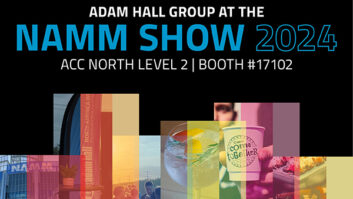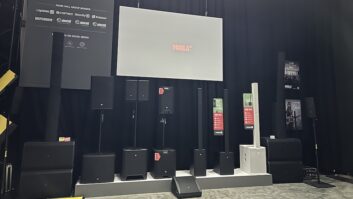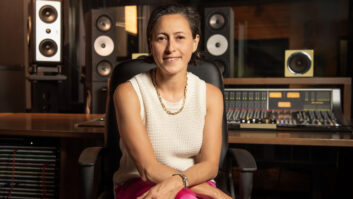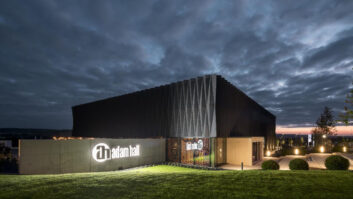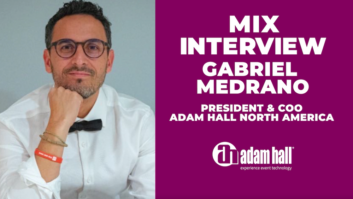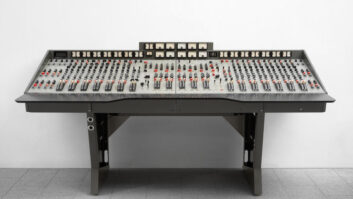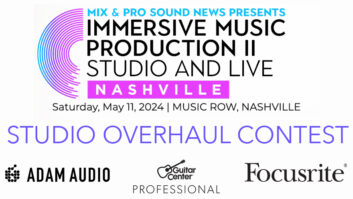New York, NY (September 26, 2019)—Queen has always packed arenas, but in the wake of the band’s Oscar-winning biopic, Bohemian Rhapsody, it’s fair to say that 2019 is one of the group’s biggest years ever. On the heels of that success, guitarist Brian May and drummer Roger Taylor hit the road this summer for the latest U.S. leg of the ongoing Rhapsody Tour. Much as he has since 2012, former American Idol contestant Adam Lambert ably fronted the musicians on stage, roaring his way nightly through the vocal acrobatics originally made famous by Freddie Mercury. Accordingly, the group these days is officially called Queen + Adam Lambert.
Mixing the six musicians—the principals plus bass, keyboards and percussion—was FOH engineer Tom New, who joined the production in 2014 as a system engineer, eventually moving to the house desk at the end of 2015. The desk in question was a DiGiCo SD5, used to look after 88 inputs. “The SD5 has a bank of buttons called Macros, which can be assigned to do anything you want,” he noted. “Rather than running snapshots as a lot of people do, I assign buttons for certain effects cues, be it a delay on Adam’s vocal, a different snare reverb or something else. I have that on a button rather than on a global snapshot, as I don’t like to do something where I can’t see what I’m doing. A button that has only two functions reduces that risk.”
While some engineers opt to use a Universal Audio UAD Realtime Rack as their software plug-in host system and others prefer Waves SoundGrid Extreme server, New gets the best of both worlds as he uses both: “Our three Realtime Racks give me 48 processing channels, and the Extreme server is doing about 12 for me. Mostly the UADs are dynamic effects and the Waves is delay effects, like reverb and things like that.”
Reinventing Arena Acoustics for the Bohemian Rhapsody Premiere
The production had a fair number of visual delights—moving video screens, lifts beneath the band members and a 50-foot thrust leading out to a sizable B-stage, all of which took time to get together. “We did rehearsals in London for a week before we came out here,” recalled New. “Then we did 10 days of production rehearsals in Anaheim, so we had plenty of rehearsal and went into the first show ready.
“Things that affect us—like there’s a drum lift, for instance—are just a case of cable management and being well-rehearsed to know when things are happening, because stuff is being patched live. You have to be aware so that things aren’t un-patched when they’re live in the P.A.! That’s been a part of the show for quite a long time, however, so we’re all quite well used to that [aspect].”
Clair Global, the band’s longtime audio provider, fielded a sizable P.A. for the tour, centered around its legacy i-5 proprietary line arrays. The system, hung to cover 270° nightly, featured main hangs of 14 i-5D line array boxes per side, side hangs of a dozen i-5s each, and rear hangs of eight i-5s.
But then there was the B-stage, used for a stripped-back acoustic set and situated more than 50 feet out into the audience at the end of the thrust. To aid feedback rejection, the production uniquely deployed small arrays of Clair’s Cohesion CO-10 loudspeakers above the end of the B-stage, hung perpendicularly to the stage to cover the audience area on either side of the thrust. As a result, the main P.A. could be aimed to hit the crowd beyond the end of the thrust. New explained, “You’ve got acoustic guitar, three vocals and drums down there, and it could be a real nightmare if you have the P.A. pointing at it as well when the monitor system is already quite loud.”
As is often the case with classic rock bands, that loud monitor system consisted largely of wedges. May, Taylor and keyboardist Spike Edney heard themselves via 13 Clair CM22 and 20 Clair CM14 wedges, bolstered by eight CO-10s for side fills, with two grounded and two flown on each side of the stage. Meanwhile, Lambert, bassist Neil Fairclough and percussionist Tyler Warren heard themselves via both Shure PSM 1000 IEM systems and wedges, though Taylor also used a single in-ear monitor for one song nightly.

Monitor mixing duties were handled on more SD5 consoles, with Niall Slevin looking after Lambert’s IEM mix and Ben Rothstein covering everyone else. Opting to use only onboard effects, Rothstein aimed to keep everything as balanced and authentic as possible: “I want the drums to come back to them sounding like how the actual drums sound acoustically. I’m making sure the guitar coming out of the wedges sounds as much like the guitar coming out of the amps as possible.”
Rothstein had taken over the monitor position in September 2018, so things were in good order by the time the summer tour rolled around. “I think now we’re in a place where they are happy with those sounds—now I try to tailor the mixes to fill in the gaps, as it were,” he said. “Being on wedges, they get a lot of stage sound directly from guitar amps and the drum kit, so I make sure that the closer you are to the drum kit, the less drums there are in the wedges. Likewise, Brian has a pair of wedges in front of him when he’s standing in front of his amps, and there’s no guitar in the wedges whatsoever. I’m trying to keep it so that the sound on stage is consistent as you walk across it.”
Queen + Adam Lambert has toured regularly in recent years, but there’s no question that the recent film has kicked things up a notch when it comes to playing the United States. Rothstein observed, “The U.S. audience always knows the music, but they don’t necessarily know how it works with some of the audience participation. Now with how the shows are portrayed in the movie, everyone’s aware of what to do in what song. It brings the American audience up to par with the way some of the European or other international audiences are, and the audience reaction is definitely more enthusiastic here now.”
That energy, in turn, creates the one musical effect you can’t get out of a console or plug-in: an excited band. “I see how they react from show to show. They feed off the crowd,” said New. “It definitely pumps them up when the crowd are going for it like they were last night here at Madison Square Garden. It makes everybody’s lives easier—they enjoy it more; we enjoy it more. It’s not what we do it for, but it definitely helps!”
Clair Global • www.clairglobal.com

